Individual Taxation Assignment: HI6028, Holmes Institute T3 2019
VerifiedAdded on 2022/08/19
|10
|1831
|11
Homework Assignment
AI Summary
This assignment solution addresses two taxation problems. The first problem calculates Emmi's assessable income, considering her earnings from a restaurant job, tips, a gift, and entertainment allowance, applying relevant sections of the ITAA 1997 and case law. The second problem provides advice to Liu, a 65-year-old woman selling Australian assets and moving to China, focusing on Capital Gains Tax (CGT) implications. It examines the sale of her house, car, business, furniture, and paintings, considering exemptions like the main residence exemption, small business concessions, and personal use asset rules. The solution provides a detailed analysis of each asset sale, determining which are subject to CGT and calculating the taxable capital gains, referencing relevant sections of ITAA 1997 and applicable case laws. The solution determines Liu's total taxable capital gains and provides a conclusion based on the analysis.
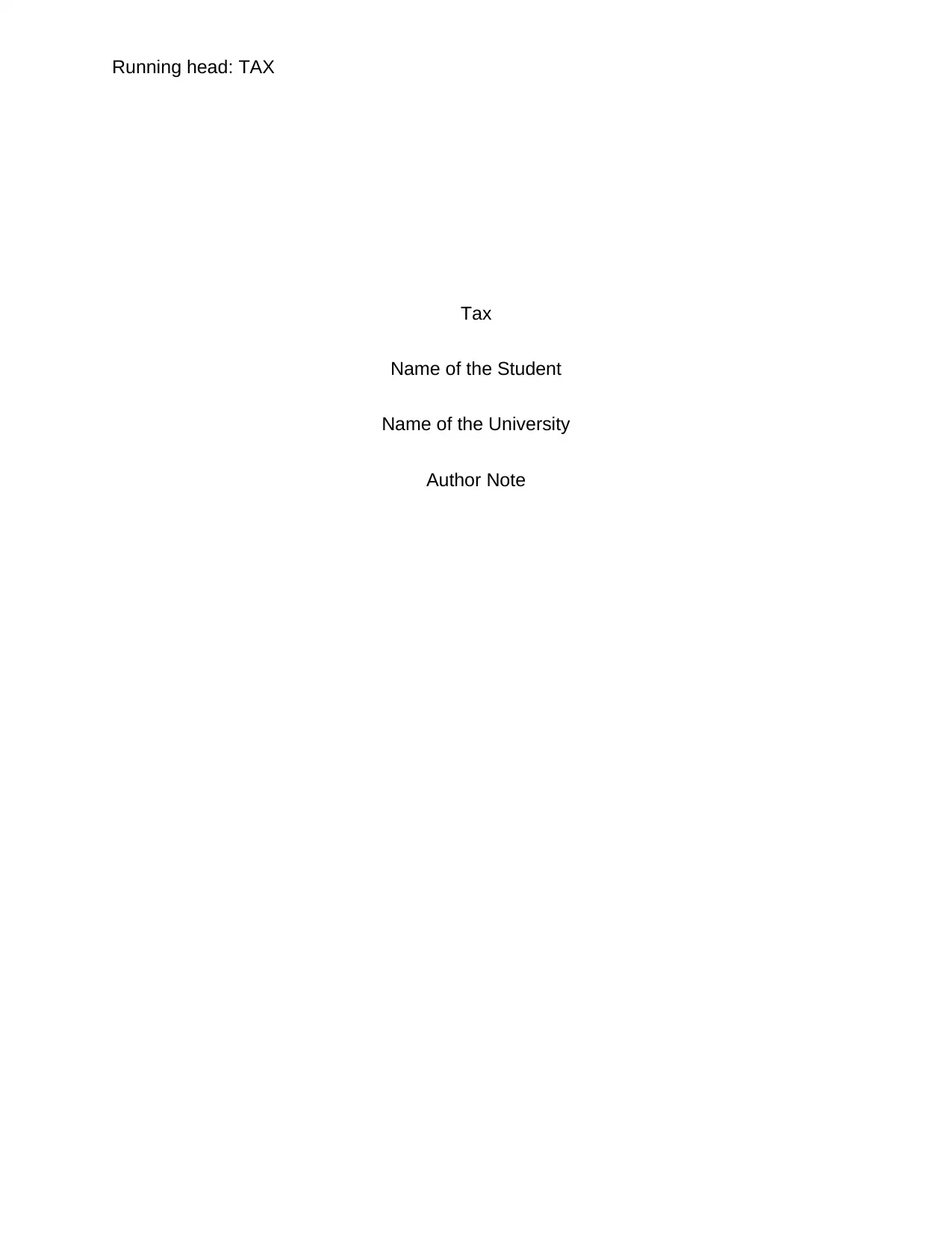
Running head: TAX
Tax
Name of the Student
Name of the University
Author Note
Tax
Name of the Student
Name of the University
Author Note
Paraphrase This Document
Need a fresh take? Get an instant paraphrase of this document with our AI Paraphraser
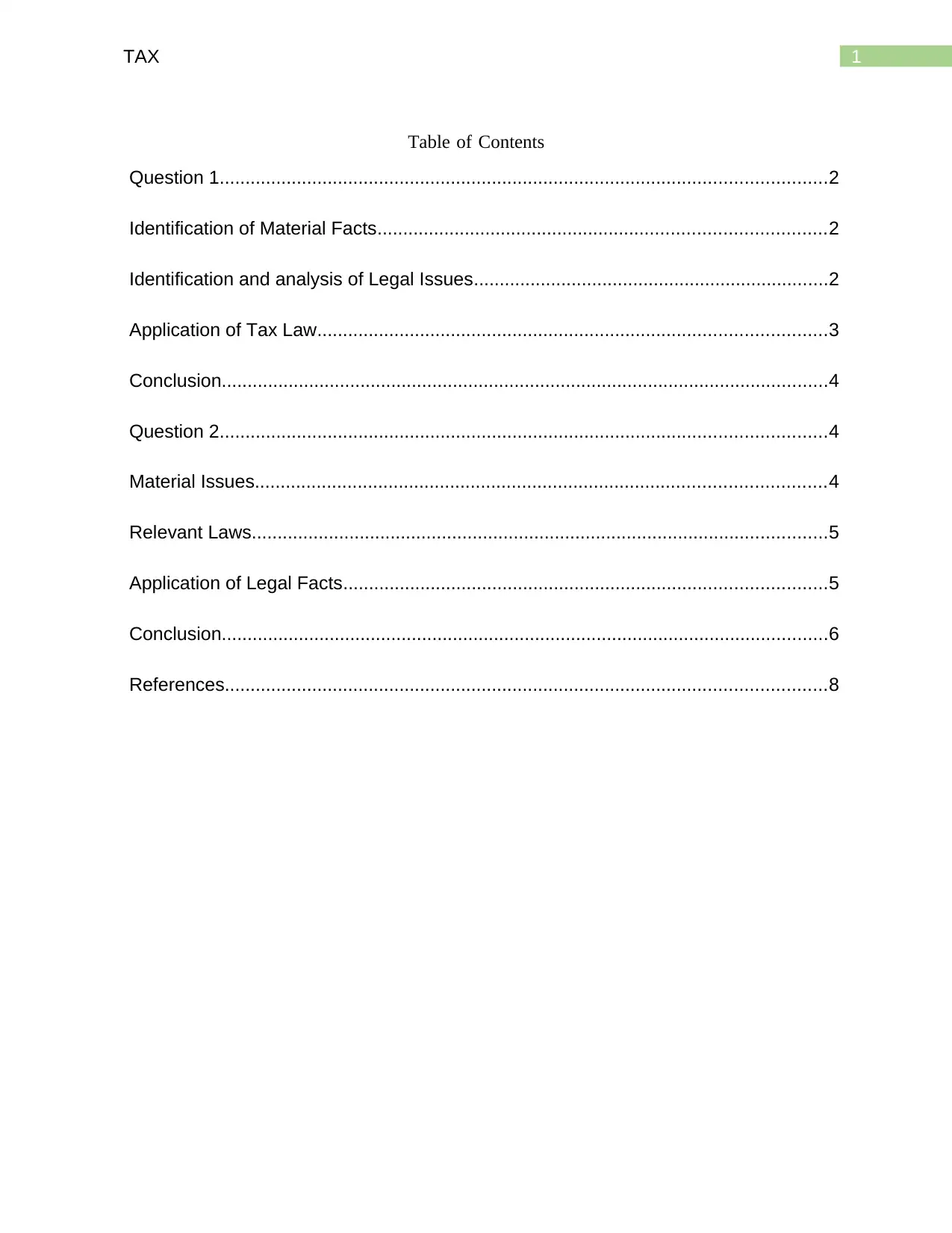
1TAX
Table of Contents
Question 1......................................................................................................................2
Identification of Material Facts.......................................................................................2
Identification and analysis of Legal Issues.....................................................................2
Application of Tax Law...................................................................................................3
Conclusion......................................................................................................................4
Question 2......................................................................................................................4
Material Issues...............................................................................................................4
Relevant Laws................................................................................................................5
Application of Legal Facts..............................................................................................5
Conclusion......................................................................................................................6
References.....................................................................................................................8
Table of Contents
Question 1......................................................................................................................2
Identification of Material Facts.......................................................................................2
Identification and analysis of Legal Issues.....................................................................2
Application of Tax Law...................................................................................................3
Conclusion......................................................................................................................4
Question 2......................................................................................................................4
Material Issues...............................................................................................................4
Relevant Laws................................................................................................................5
Application of Legal Facts..............................................................................................5
Conclusion......................................................................................................................6
References.....................................................................................................................8
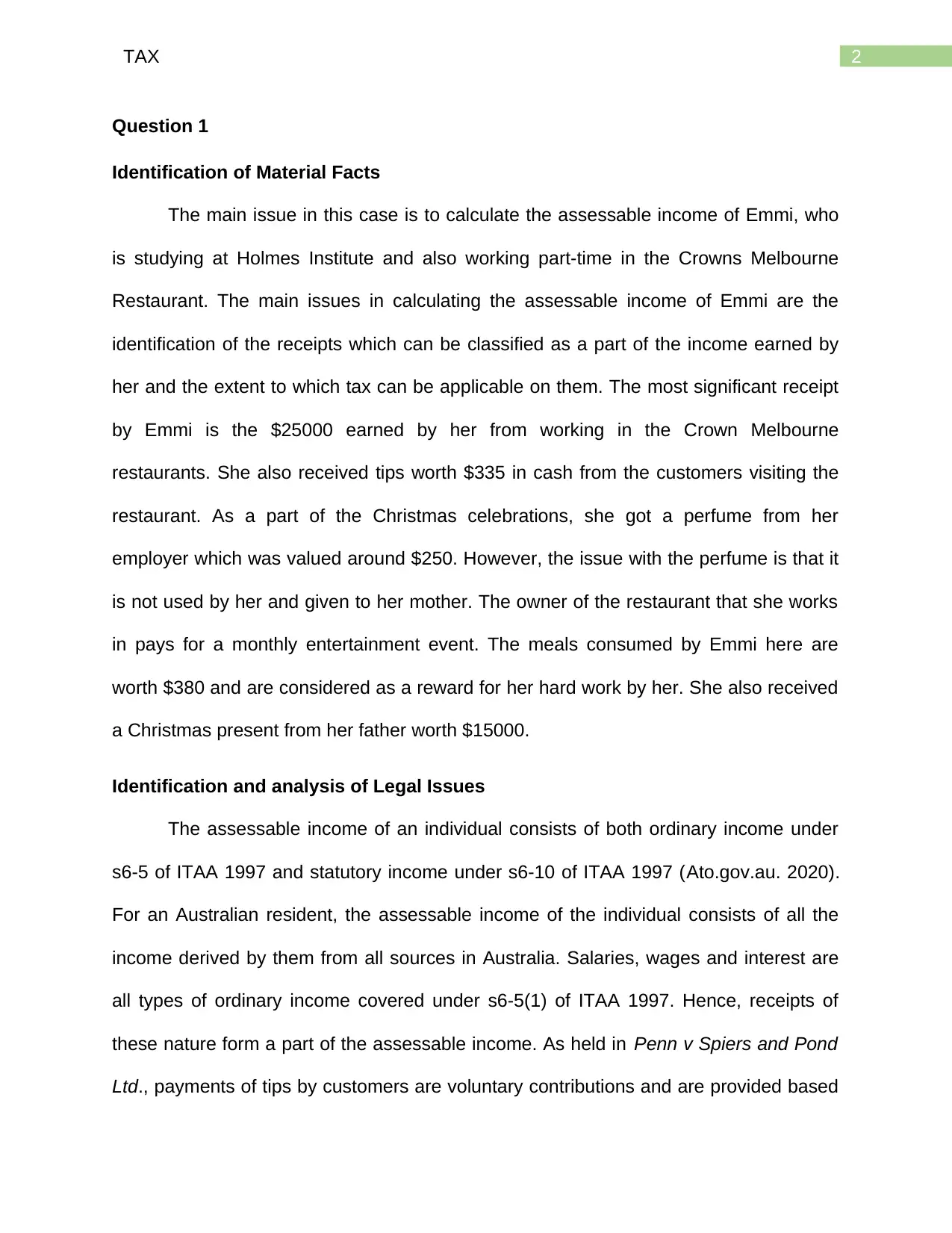
2TAX
Question 1
Identification of Material Facts
The main issue in this case is to calculate the assessable income of Emmi, who
is studying at Holmes Institute and also working part-time in the Crowns Melbourne
Restaurant. The main issues in calculating the assessable income of Emmi are the
identification of the receipts which can be classified as a part of the income earned by
her and the extent to which tax can be applicable on them. The most significant receipt
by Emmi is the $25000 earned by her from working in the Crown Melbourne
restaurants. She also received tips worth $335 in cash from the customers visiting the
restaurant. As a part of the Christmas celebrations, she got a perfume from her
employer which was valued around $250. However, the issue with the perfume is that it
is not used by her and given to her mother. The owner of the restaurant that she works
in pays for a monthly entertainment event. The meals consumed by Emmi here are
worth $380 and are considered as a reward for her hard work by her. She also received
a Christmas present from her father worth $15000.
Identification and analysis of Legal Issues
The assessable income of an individual consists of both ordinary income under
s6-5 of ITAA 1997 and statutory income under s6-10 of ITAA 1997 (Ato.gov.au. 2020).
For an Australian resident, the assessable income of the individual consists of all the
income derived by them from all sources in Australia. Salaries, wages and interest are
all types of ordinary income covered under s6-5(1) of ITAA 1997. Hence, receipts of
these nature form a part of the assessable income. As held in Penn v Spiers and Pond
Ltd., payments of tips by customers are voluntary contributions and are provided based
Question 1
Identification of Material Facts
The main issue in this case is to calculate the assessable income of Emmi, who
is studying at Holmes Institute and also working part-time in the Crowns Melbourne
Restaurant. The main issues in calculating the assessable income of Emmi are the
identification of the receipts which can be classified as a part of the income earned by
her and the extent to which tax can be applicable on them. The most significant receipt
by Emmi is the $25000 earned by her from working in the Crown Melbourne
restaurants. She also received tips worth $335 in cash from the customers visiting the
restaurant. As a part of the Christmas celebrations, she got a perfume from her
employer which was valued around $250. However, the issue with the perfume is that it
is not used by her and given to her mother. The owner of the restaurant that she works
in pays for a monthly entertainment event. The meals consumed by Emmi here are
worth $380 and are considered as a reward for her hard work by her. She also received
a Christmas present from her father worth $15000.
Identification and analysis of Legal Issues
The assessable income of an individual consists of both ordinary income under
s6-5 of ITAA 1997 and statutory income under s6-10 of ITAA 1997 (Ato.gov.au. 2020).
For an Australian resident, the assessable income of the individual consists of all the
income derived by them from all sources in Australia. Salaries, wages and interest are
all types of ordinary income covered under s6-5(1) of ITAA 1997. Hence, receipts of
these nature form a part of the assessable income. As held in Penn v Spiers and Pond
Ltd., payments of tips by customers are voluntary contributions and are provided based
⊘ This is a preview!⊘
Do you want full access?
Subscribe today to unlock all pages.

Trusted by 1+ million students worldwide
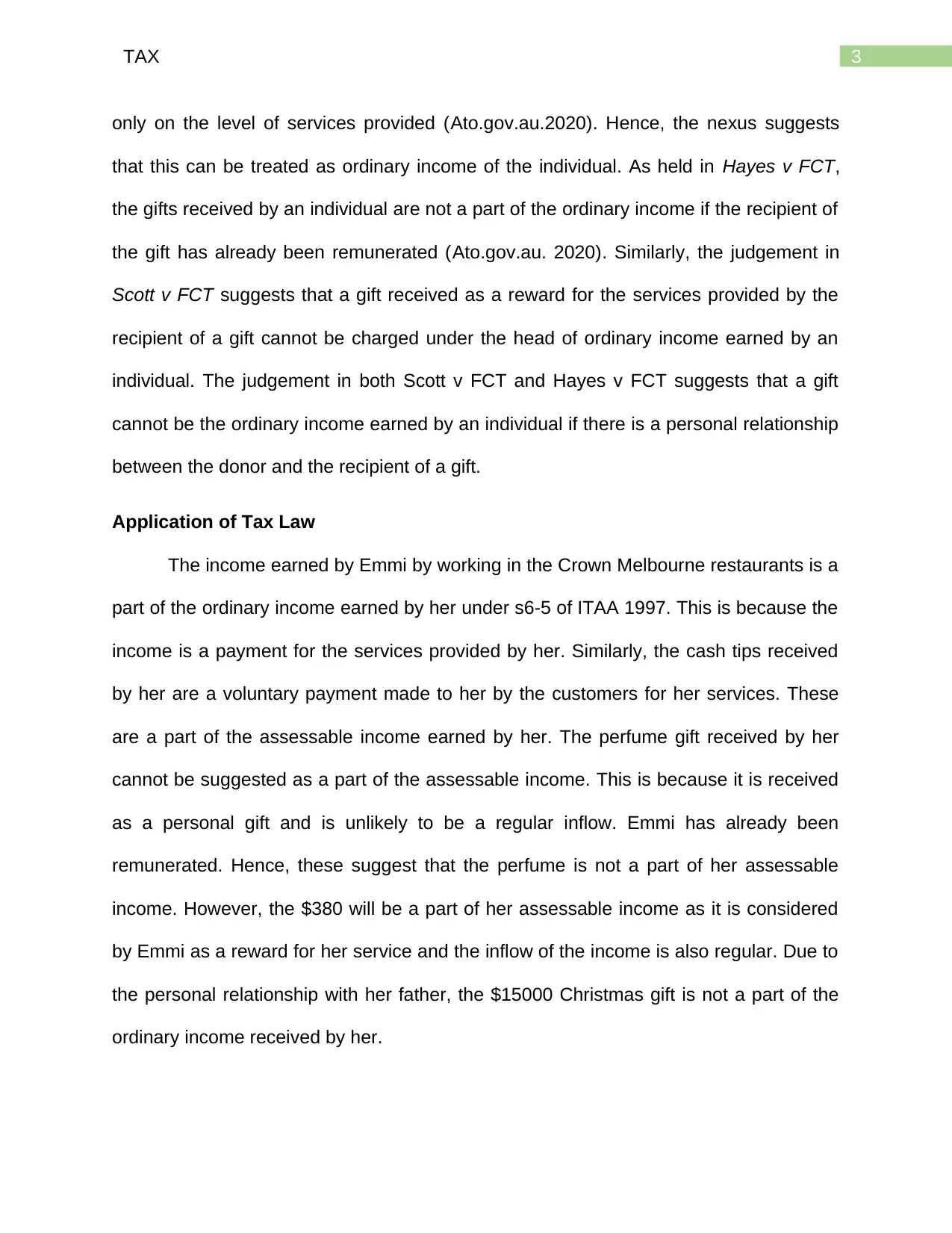
3TAX
only on the level of services provided (Ato.gov.au.2020). Hence, the nexus suggests
that this can be treated as ordinary income of the individual. As held in Hayes v FCT,
the gifts received by an individual are not a part of the ordinary income if the recipient of
the gift has already been remunerated (Ato.gov.au. 2020). Similarly, the judgement in
Scott v FCT suggests that a gift received as a reward for the services provided by the
recipient of a gift cannot be charged under the head of ordinary income earned by an
individual. The judgement in both Scott v FCT and Hayes v FCT suggests that a gift
cannot be the ordinary income earned by an individual if there is a personal relationship
between the donor and the recipient of a gift.
Application of Tax Law
The income earned by Emmi by working in the Crown Melbourne restaurants is a
part of the ordinary income earned by her under s6-5 of ITAA 1997. This is because the
income is a payment for the services provided by her. Similarly, the cash tips received
by her are a voluntary payment made to her by the customers for her services. These
are a part of the assessable income earned by her. The perfume gift received by her
cannot be suggested as a part of the assessable income. This is because it is received
as a personal gift and is unlikely to be a regular inflow. Emmi has already been
remunerated. Hence, these suggest that the perfume is not a part of her assessable
income. However, the $380 will be a part of her assessable income as it is considered
by Emmi as a reward for her service and the inflow of the income is also regular. Due to
the personal relationship with her father, the $15000 Christmas gift is not a part of the
ordinary income received by her.
only on the level of services provided (Ato.gov.au.2020). Hence, the nexus suggests
that this can be treated as ordinary income of the individual. As held in Hayes v FCT,
the gifts received by an individual are not a part of the ordinary income if the recipient of
the gift has already been remunerated (Ato.gov.au. 2020). Similarly, the judgement in
Scott v FCT suggests that a gift received as a reward for the services provided by the
recipient of a gift cannot be charged under the head of ordinary income earned by an
individual. The judgement in both Scott v FCT and Hayes v FCT suggests that a gift
cannot be the ordinary income earned by an individual if there is a personal relationship
between the donor and the recipient of a gift.
Application of Tax Law
The income earned by Emmi by working in the Crown Melbourne restaurants is a
part of the ordinary income earned by her under s6-5 of ITAA 1997. This is because the
income is a payment for the services provided by her. Similarly, the cash tips received
by her are a voluntary payment made to her by the customers for her services. These
are a part of the assessable income earned by her. The perfume gift received by her
cannot be suggested as a part of the assessable income. This is because it is received
as a personal gift and is unlikely to be a regular inflow. Emmi has already been
remunerated. Hence, these suggest that the perfume is not a part of her assessable
income. However, the $380 will be a part of her assessable income as it is considered
by Emmi as a reward for her service and the inflow of the income is also regular. Due to
the personal relationship with her father, the $15000 Christmas gift is not a part of the
ordinary income received by her.
Paraphrase This Document
Need a fresh take? Get an instant paraphrase of this document with our AI Paraphraser
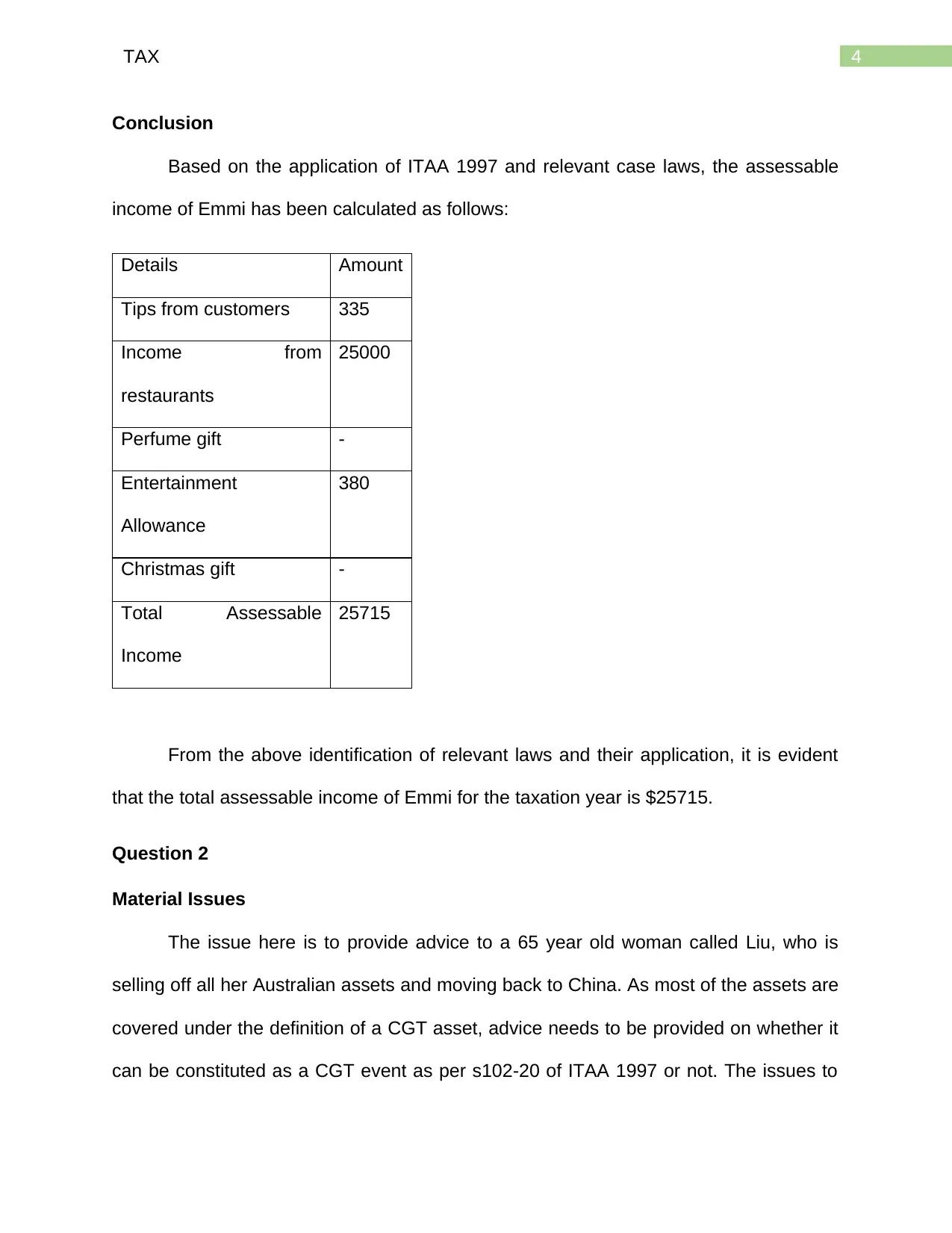
4TAX
Conclusion
Based on the application of ITAA 1997 and relevant case laws, the assessable
income of Emmi has been calculated as follows:
Details Amount
Tips from customers 335
Income from
restaurants
25000
Perfume gift -
Entertainment
Allowance
380
Christmas gift -
Total Assessable
Income
25715
From the above identification of relevant laws and their application, it is evident
that the total assessable income of Emmi for the taxation year is $25715.
Question 2
Material Issues
The issue here is to provide advice to a 65 year old woman called Liu, who is
selling off all her Australian assets and moving back to China. As most of the assets are
covered under the definition of a CGT asset, advice needs to be provided on whether it
can be constituted as a CGT event as per s102-20 of ITAA 1997 or not. The issues to
Conclusion
Based on the application of ITAA 1997 and relevant case laws, the assessable
income of Emmi has been calculated as follows:
Details Amount
Tips from customers 335
Income from
restaurants
25000
Perfume gift -
Entertainment
Allowance
380
Christmas gift -
Total Assessable
Income
25715
From the above identification of relevant laws and their application, it is evident
that the total assessable income of Emmi for the taxation year is $25715.
Question 2
Material Issues
The issue here is to provide advice to a 65 year old woman called Liu, who is
selling off all her Australian assets and moving back to China. As most of the assets are
covered under the definition of a CGT asset, advice needs to be provided on whether it
can be constituted as a CGT event as per s102-20 of ITAA 1997 or not. The issues to

5TAX
be considered in this regard include the date on which the asset was procured and
whether the asset is a personal use asset under s108-20 of ITAA 1997. Similarly, the
exemption available to small businesses and whether any further exemptions available
to Liu on the sales undertaken by her should also be taken into consideration.
Relevant Laws
In Australia, CGT became applicable from 20 September 1985. Hence, many
assets purchased prior to this date are exempt from CGT. Under s118-100 of Part 3-1
of ITAA 1997, any capital gain or loss incurred from the sale of a CGT asset is
disregarded if that asset is the main residence of the taxpayer (Ato.gov.au. 2020).
However, the house property should only be used for residential purposes and not for
any other income producing or generating purposes. Under s118-5 of ITAA 1997, the
capital gains or losses from the sale of a car should be disregarded. The definition of a
car is stated by s995-1 of ITAA 1997 (Ato.gov.au. 2020). Subdivision 152-A of ITAA
1997 deals with relief available to a taxpayer on the sale of a small business. Generally,
these include the 15-year exemption, 50% reduction, retirement concession and
replacement-asset rollover (Legislation.gov.au 2020). The retirement concession is
available to people selling the assets available with them and retiring after that. For
people aged above 55, this exemption is given up to a lifetime limit of $500000. Under
s118-10(3) of ITAA 1997, the capital gains earned from the sale of a personal use asset
are to be disregarded if they were purchased for an amount less than $10000.
According to s119-10(1) of ITAA 1997, a collectable is exempt from CGT if it was
acquired for lower than $500 (Ato.gov.au. 2020).
be considered in this regard include the date on which the asset was procured and
whether the asset is a personal use asset under s108-20 of ITAA 1997. Similarly, the
exemption available to small businesses and whether any further exemptions available
to Liu on the sales undertaken by her should also be taken into consideration.
Relevant Laws
In Australia, CGT became applicable from 20 September 1985. Hence, many
assets purchased prior to this date are exempt from CGT. Under s118-100 of Part 3-1
of ITAA 1997, any capital gain or loss incurred from the sale of a CGT asset is
disregarded if that asset is the main residence of the taxpayer (Ato.gov.au. 2020).
However, the house property should only be used for residential purposes and not for
any other income producing or generating purposes. Under s118-5 of ITAA 1997, the
capital gains or losses from the sale of a car should be disregarded. The definition of a
car is stated by s995-1 of ITAA 1997 (Ato.gov.au. 2020). Subdivision 152-A of ITAA
1997 deals with relief available to a taxpayer on the sale of a small business. Generally,
these include the 15-year exemption, 50% reduction, retirement concession and
replacement-asset rollover (Legislation.gov.au 2020). The retirement concession is
available to people selling the assets available with them and retiring after that. For
people aged above 55, this exemption is given up to a lifetime limit of $500000. Under
s118-10(3) of ITAA 1997, the capital gains earned from the sale of a personal use asset
are to be disregarded if they were purchased for an amount less than $10000.
According to s119-10(1) of ITAA 1997, a collectable is exempt from CGT if it was
acquired for lower than $500 (Ato.gov.au. 2020).
⊘ This is a preview!⊘
Do you want full access?
Subscribe today to unlock all pages.

Trusted by 1+ million students worldwide
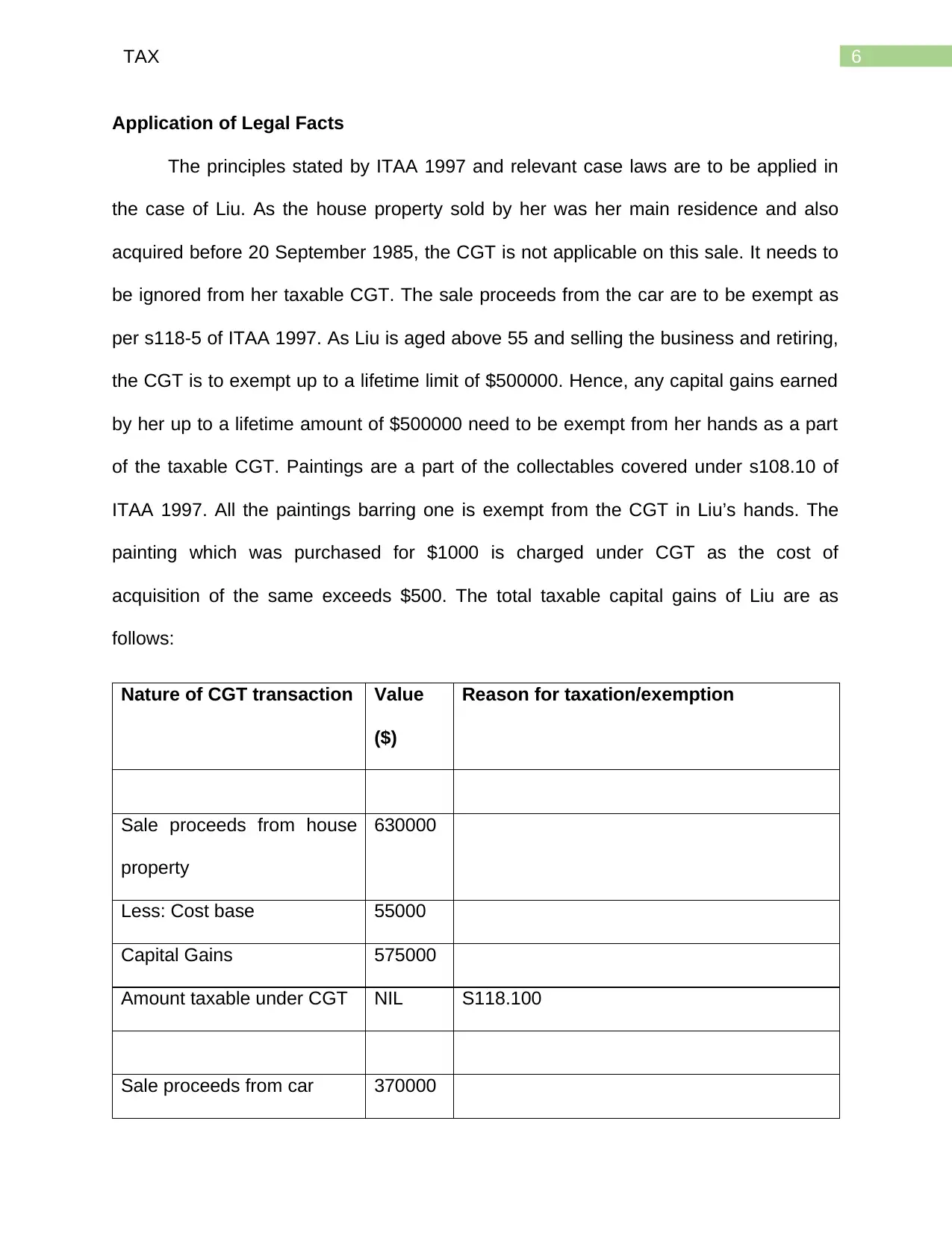
6TAX
Application of Legal Facts
The principles stated by ITAA 1997 and relevant case laws are to be applied in
the case of Liu. As the house property sold by her was her main residence and also
acquired before 20 September 1985, the CGT is not applicable on this sale. It needs to
be ignored from her taxable CGT. The sale proceeds from the car are to be exempt as
per s118-5 of ITAA 1997. As Liu is aged above 55 and selling the business and retiring,
the CGT is to exempt up to a lifetime limit of $500000. Hence, any capital gains earned
by her up to a lifetime amount of $500000 need to be exempt from her hands as a part
of the taxable CGT. Paintings are a part of the collectables covered under s108.10 of
ITAA 1997. All the paintings barring one is exempt from the CGT in Liu’s hands. The
painting which was purchased for $1000 is charged under CGT as the cost of
acquisition of the same exceeds $500. The total taxable capital gains of Liu are as
follows:
Nature of CGT transaction Value
($)
Reason for taxation/exemption
Sale proceeds from house
property
630000
Less: Cost base 55000
Capital Gains 575000
Amount taxable under CGT NIL S118.100
Sale proceeds from car 370000
Application of Legal Facts
The principles stated by ITAA 1997 and relevant case laws are to be applied in
the case of Liu. As the house property sold by her was her main residence and also
acquired before 20 September 1985, the CGT is not applicable on this sale. It needs to
be ignored from her taxable CGT. The sale proceeds from the car are to be exempt as
per s118-5 of ITAA 1997. As Liu is aged above 55 and selling the business and retiring,
the CGT is to exempt up to a lifetime limit of $500000. Hence, any capital gains earned
by her up to a lifetime amount of $500000 need to be exempt from her hands as a part
of the taxable CGT. Paintings are a part of the collectables covered under s108.10 of
ITAA 1997. All the paintings barring one is exempt from the CGT in Liu’s hands. The
painting which was purchased for $1000 is charged under CGT as the cost of
acquisition of the same exceeds $500. The total taxable capital gains of Liu are as
follows:
Nature of CGT transaction Value
($)
Reason for taxation/exemption
Sale proceeds from house
property
630000
Less: Cost base 55000
Capital Gains 575000
Amount taxable under CGT NIL S118.100
Sale proceeds from car 370000
Paraphrase This Document
Need a fresh take? Get an instant paraphrase of this document with our AI Paraphraser
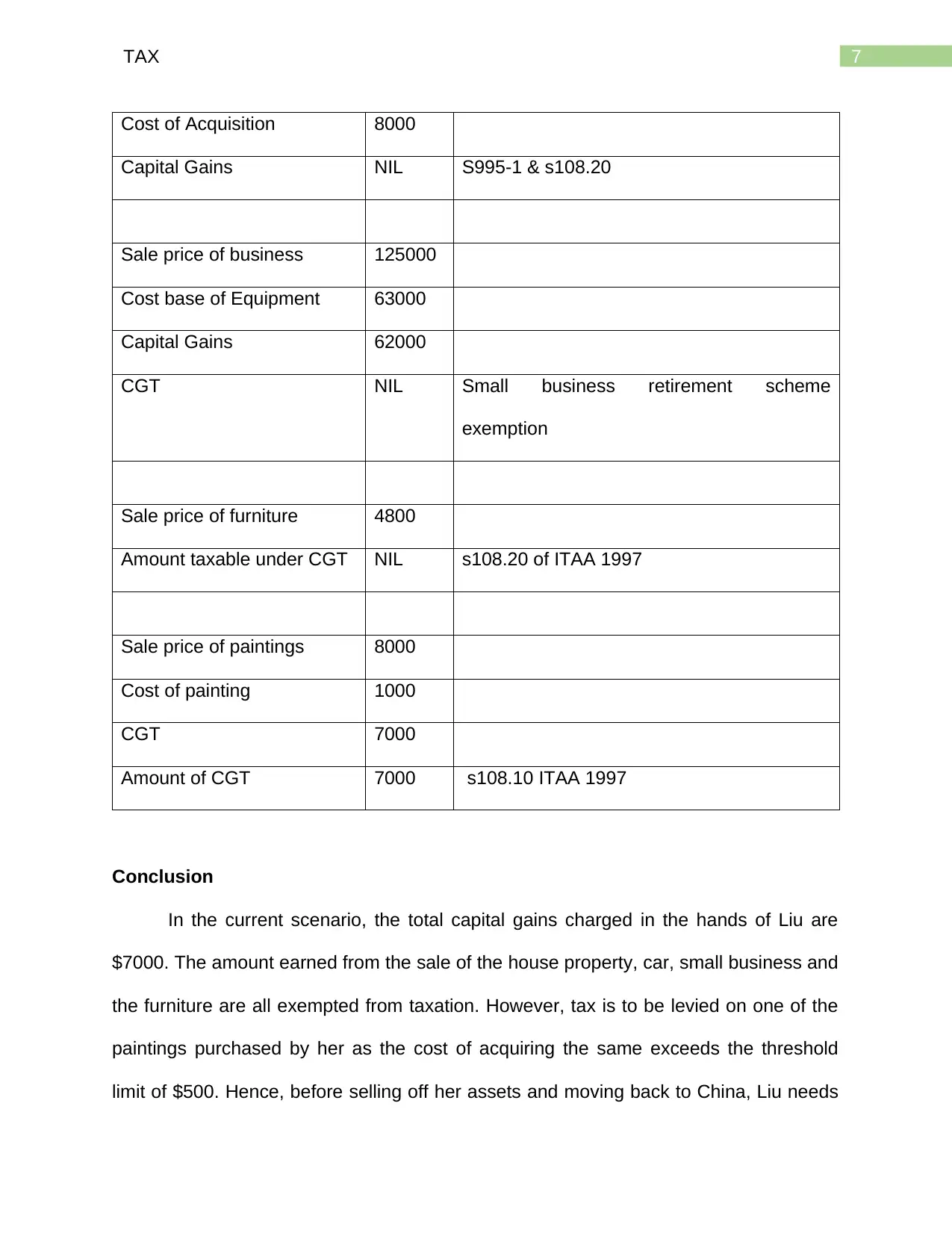
7TAX
Cost of Acquisition 8000
Capital Gains NIL S995-1 & s108.20
Sale price of business 125000
Cost base of Equipment 63000
Capital Gains 62000
CGT NIL Small business retirement scheme
exemption
Sale price of furniture 4800
Amount taxable under CGT NIL s108.20 of ITAA 1997
Sale price of paintings 8000
Cost of painting 1000
CGT 7000
Amount of CGT 7000 s108.10 ITAA 1997
Conclusion
In the current scenario, the total capital gains charged in the hands of Liu are
$7000. The amount earned from the sale of the house property, car, small business and
the furniture are all exempted from taxation. However, tax is to be levied on one of the
paintings purchased by her as the cost of acquiring the same exceeds the threshold
limit of $500. Hence, before selling off her assets and moving back to China, Liu needs
Cost of Acquisition 8000
Capital Gains NIL S995-1 & s108.20
Sale price of business 125000
Cost base of Equipment 63000
Capital Gains 62000
CGT NIL Small business retirement scheme
exemption
Sale price of furniture 4800
Amount taxable under CGT NIL s108.20 of ITAA 1997
Sale price of paintings 8000
Cost of painting 1000
CGT 7000
Amount of CGT 7000 s108.10 ITAA 1997
Conclusion
In the current scenario, the total capital gains charged in the hands of Liu are
$7000. The amount earned from the sale of the house property, car, small business and
the furniture are all exempted from taxation. However, tax is to be levied on one of the
paintings purchased by her as the cost of acquiring the same exceeds the threshold
limit of $500. Hence, before selling off her assets and moving back to China, Liu needs
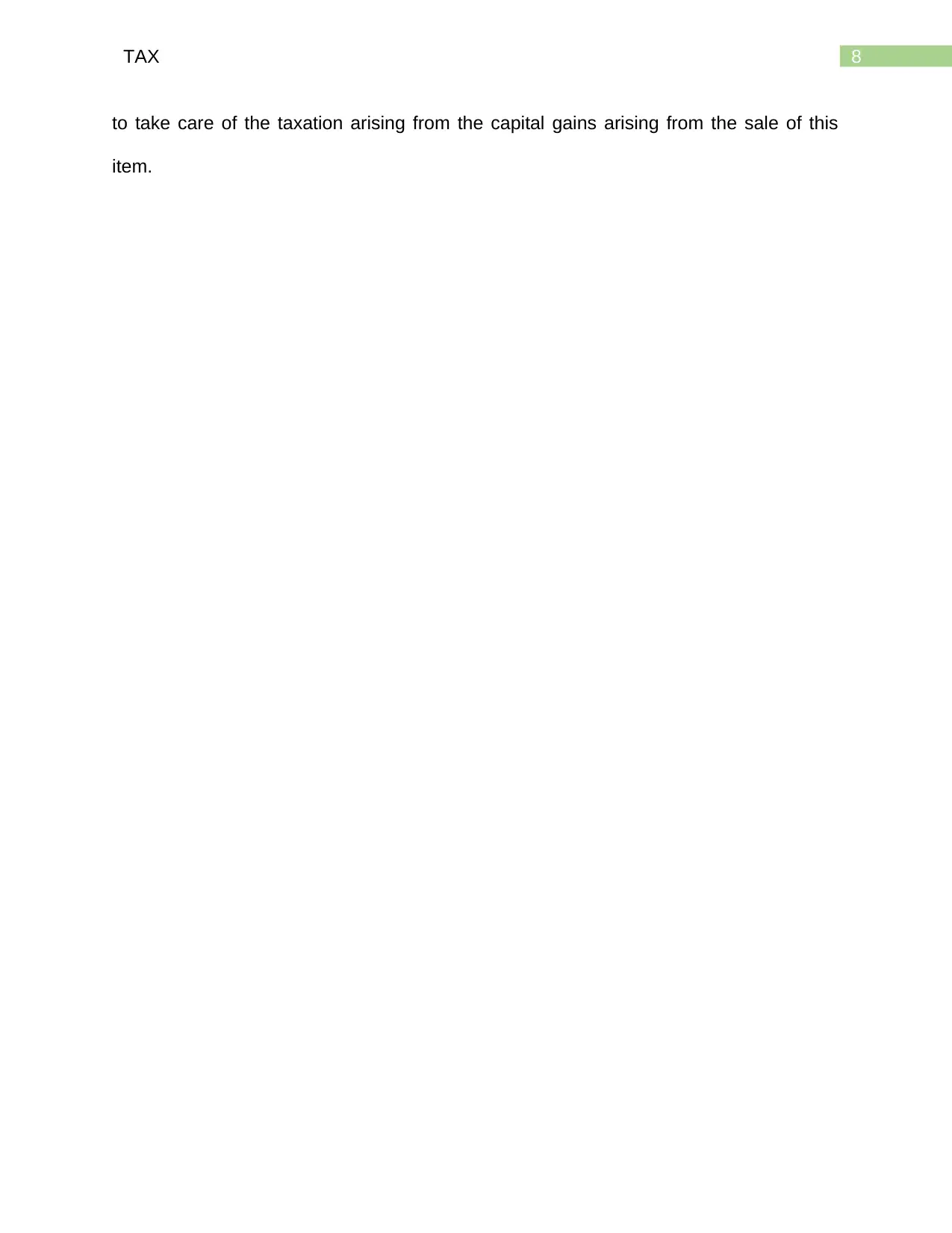
8TAX
to take care of the taxation arising from the capital gains arising from the sale of this
item.
to take care of the taxation arising from the capital gains arising from the sale of this
item.
⊘ This is a preview!⊘
Do you want full access?
Subscribe today to unlock all pages.

Trusted by 1+ million students worldwide
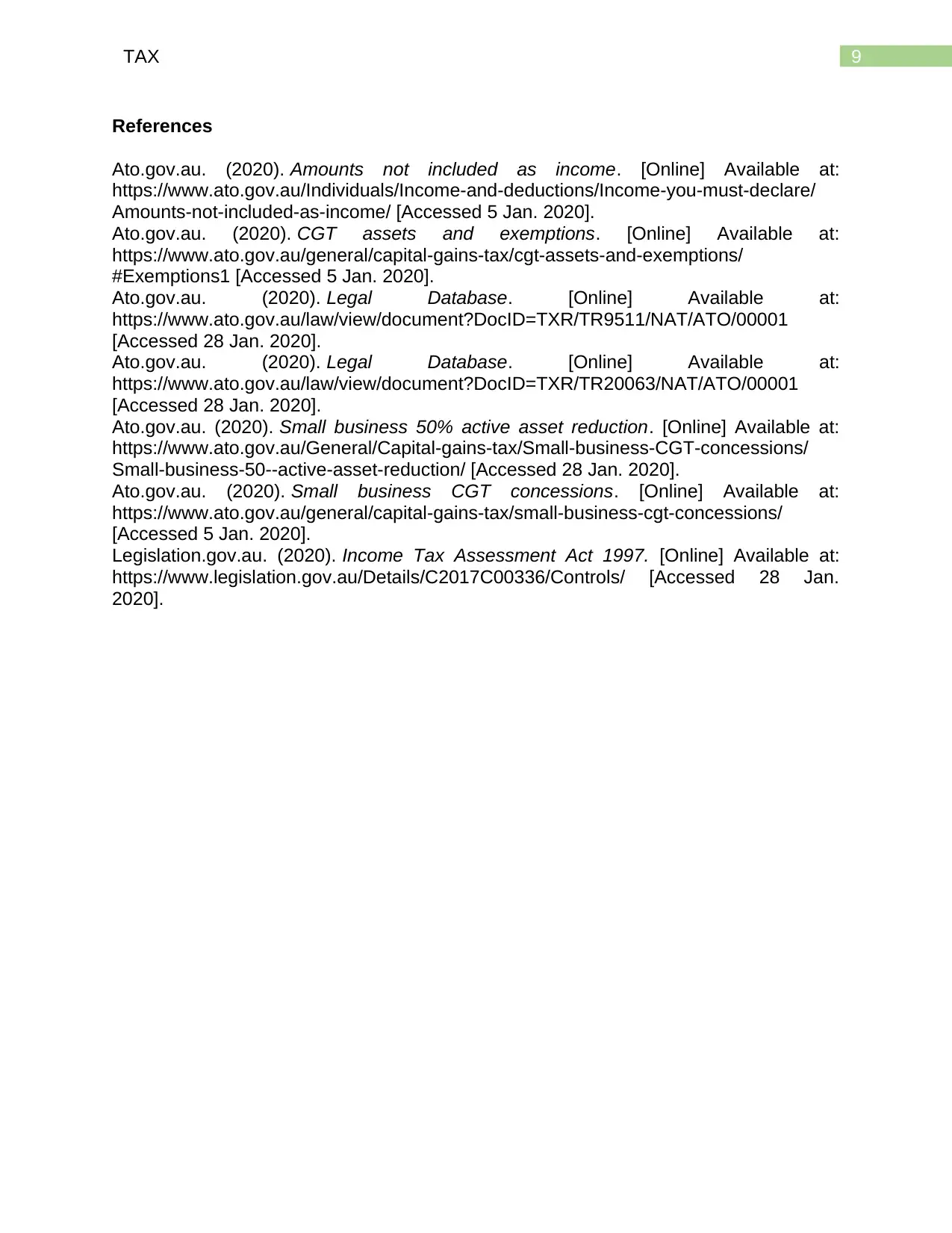
9TAX
References
Ato.gov.au. (2020). Amounts not included as income. [Online] Available at:
https://www.ato.gov.au/Individuals/Income-and-deductions/Income-you-must-declare/
Amounts-not-included-as-income/ [Accessed 5 Jan. 2020].
Ato.gov.au. (2020). CGT assets and exemptions. [Online] Available at:
https://www.ato.gov.au/general/capital-gains-tax/cgt-assets-and-exemptions/
#Exemptions1 [Accessed 5 Jan. 2020].
Ato.gov.au. (2020). Legal Database. [Online] Available at:
https://www.ato.gov.au/law/view/document?DocID=TXR/TR9511/NAT/ATO/00001
[Accessed 28 Jan. 2020].
Ato.gov.au. (2020). Legal Database. [Online] Available at:
https://www.ato.gov.au/law/view/document?DocID=TXR/TR20063/NAT/ATO/00001
[Accessed 28 Jan. 2020].
Ato.gov.au. (2020). Small business 50% active asset reduction. [Online] Available at:
https://www.ato.gov.au/General/Capital-gains-tax/Small-business-CGT-concessions/
Small-business-50--active-asset-reduction/ [Accessed 28 Jan. 2020].
Ato.gov.au. (2020). Small business CGT concessions. [Online] Available at:
https://www.ato.gov.au/general/capital-gains-tax/small-business-cgt-concessions/
[Accessed 5 Jan. 2020].
Legislation.gov.au. (2020). Income Tax Assessment Act 1997. [Online] Available at:
https://www.legislation.gov.au/Details/C2017C00336/Controls/ [Accessed 28 Jan.
2020].
References
Ato.gov.au. (2020). Amounts not included as income. [Online] Available at:
https://www.ato.gov.au/Individuals/Income-and-deductions/Income-you-must-declare/
Amounts-not-included-as-income/ [Accessed 5 Jan. 2020].
Ato.gov.au. (2020). CGT assets and exemptions. [Online] Available at:
https://www.ato.gov.au/general/capital-gains-tax/cgt-assets-and-exemptions/
#Exemptions1 [Accessed 5 Jan. 2020].
Ato.gov.au. (2020). Legal Database. [Online] Available at:
https://www.ato.gov.au/law/view/document?DocID=TXR/TR9511/NAT/ATO/00001
[Accessed 28 Jan. 2020].
Ato.gov.au. (2020). Legal Database. [Online] Available at:
https://www.ato.gov.au/law/view/document?DocID=TXR/TR20063/NAT/ATO/00001
[Accessed 28 Jan. 2020].
Ato.gov.au. (2020). Small business 50% active asset reduction. [Online] Available at:
https://www.ato.gov.au/General/Capital-gains-tax/Small-business-CGT-concessions/
Small-business-50--active-asset-reduction/ [Accessed 28 Jan. 2020].
Ato.gov.au. (2020). Small business CGT concessions. [Online] Available at:
https://www.ato.gov.au/general/capital-gains-tax/small-business-cgt-concessions/
[Accessed 5 Jan. 2020].
Legislation.gov.au. (2020). Income Tax Assessment Act 1997. [Online] Available at:
https://www.legislation.gov.au/Details/C2017C00336/Controls/ [Accessed 28 Jan.
2020].
1 out of 10
Related Documents
Your All-in-One AI-Powered Toolkit for Academic Success.
+13062052269
info@desklib.com
Available 24*7 on WhatsApp / Email
![[object Object]](/_next/static/media/star-bottom.7253800d.svg)
Unlock your academic potential
Copyright © 2020–2025 A2Z Services. All Rights Reserved. Developed and managed by ZUCOL.





